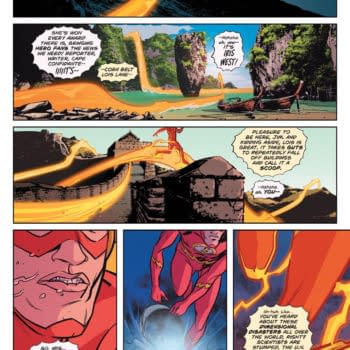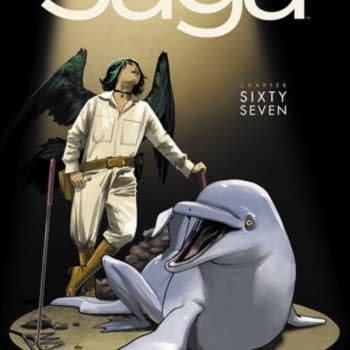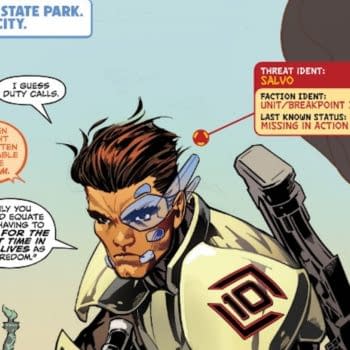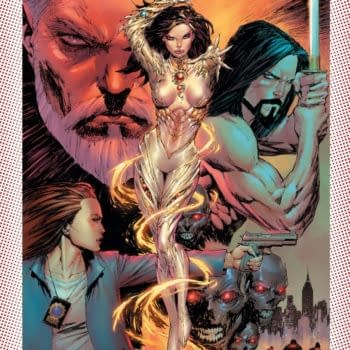Posted in: Comics, Recent Updates | Tagged: Comics, comics industry, dc, dc comics, diversity in comics, entertainment, Gender In Comics, gendercrunching, marvel, Marvel Comics
Gendercrunching June 2014 – Including Nationality And Ethnicity At The Big Two
By Tim Hanley
After posting the higher percentage of female creators for six straight months, DC was finally toppled by Marvel in June. DC took a tumble while Marvel gained slightly, and it all was enough for Marvel to finally regain the top spot after a lengthy dry spell. We're also looking at nationality and ethnicity among the Big Two creators this month, and perhaps not surprisingly they're a rather homogenous bunch.
DC COMICS
DC took a bit of a tumble this month, and it's pretty easy to see why when you break down the numbers. In June 2014, DC Comics released 68 comic books featuring 577 credited creators, 519 men and 58 women. Here are their stats:
A drop of 1.7% overall may not seem like a big deal, but when the percentages are so low to begin with that it's not an insignificant loss. The biggest drop was among assistant editors, which fell nearly 10% from May's totals. A lot of female editors have left DC and have been replaced by male editors, and that category, usually a bastion of female representation at the Big Two, is now shockingly low for DC. Cover artists had a 6% drop while colorists rose 4%, and everything else stayed roughly the same. All together, the assistant editor situation is DC's Achilles heel right now and is dragging down their overall percentage.
Compared To A Year Ago: Last June, DC Comics had 11.7% female creators, so they're down 1.6% since then.
MARVEL COMICS
Marvel was up and down across the board, but the growth outweighed the losses as they rose slightly. In June 2014, Marvel put out 75 comics with 619 credited creators, 545 men and 74 women. Let's look at their numbers:
Rising 0.3% overall isn't huge, but Marvel taking the top spot in June with ease is a big change. The categories were chaotic: cover artists, pencillers, inkers, colorists, and editors all rose a little bit, while writers and assistant editors each fell fairly hard, with losses of 3% and almost 7% respectively. But a series of decent gains was enough to counteract the losses and bump Marvel up overall. How long they can hold it remains to be seen, but hopefully they can keep up the strong numbers moving forward.
Compared To A Year Ago: Marvel was at 14.1% last June, so despite taking the top spot they're down 2.1% since then.
NATIONALITY AND ETHNICITY AT THE BIG TWO
I've got shocking news, gang. You may want to be sitting down for this surprising revelation. After crunching all the numbers, it looks like superhero comics are still being made primarily by white men. I'm blowing your minds, I know, but it's true. They are dominating the field.
Before we get into the ethnicity stuff, let's take a look at nationality. This is the third summer in a row that we've looked at these numbers and not a lot has changed, especially compared to last year. I should point out that these numbers are for the solicited creators, ie. the cover artists, writers, and interior artists, so it's a smaller pool of creators than the DC and Marvel stats above. We've also combined the DC and Marvels solicits into one set of data, as we do every year. Here are the nationality stats:
The United States is tops again, by far, for the third straight year, posting their highest percentage yet. The United Kingdom is a very distant second, though they've increased their total from 2013. Spain, Brazil, and Canada are the next three (kudos to my home and native land for our 0.3% jump; we'll be gunning for third next year!), while Italy, Philippines, Argentina, and Mexico comprise the last few countries that are entering the territory of being so miniscule you can't actually see them.
There were thirteen more nations who were too small to include on the chart. Croatia had three creators for 0.9% overall; Australia, Germany, Ireland, and Malaysia each had two creators, and then there were a few with one each. The big story here, though, is the ever increasing dominance of the United States, which isn't terribly surprising given where the comics are published.
Moving on to ethnicity, we should first talk about methodology and terminology. I realize that ethnicity is very much about self-identification and what parts of your heritage you most connect to, but for the purposes of this study I've had to gauge ethnicity on my own, relying on the creator's appearance, country of origin, and other factors to categorize them. The categories are very broad, and may not necessarily match each creator's preferred nomenclature, for which I apologize. Here's how it breaks down: "White" is for the many pale people of North American and European origin; "Hispanic" covers those of Central and Southern American origin, including those living elsewhere in the world currently; "Asian" counts origins in the entirety of Asia and most of the Pacific island nations; and "Black" covers people of African origin living across the globe.
All of that being said, let's look at how the 323 different credited, solicited creators at the Big Two in June 2014 break down by gender and ethnicity:
First off, there aren't many women. Focusing on just cover artists, writers, and interior artists significantly drops the numbers from what we've seen above. The totals are comparable to last year, and remain better than 2012, but 5.6% female creators remains ridiculously low.
As for white creators, they're dominating the superhero industry by a wide margin, and have increased slightly from last year's total. It's not a huge jump, but it definitely would have been nice to see a decrease here and some growth elsewhere. Instead, everything else was down, albeit slightly for some.
Hispanic and Asian creators both dropped a very minor amount, so small as to be statistically insignificant given a reasonable margin of error for this study. Nonetheless, both were down after slight gains in 2012, though those gains weren't huge either. In short, nothing has really changed anywhere at the Big Two over the past three years.
Except, unfortunately, for black creators. After some growth in 2012, they fell to their lowest level yet this year. This 1.2% represents only four creators, a big decline from last year's ten. On the plus side, two of 2014's black creators were new additions to the ranks of the Big Two, but on the negative side, that means that most of the black creators working at the Big Two in 2013 were no longer there in 2014. Given the sizeable ranks of talented black creators available to the Big Two, a paltry 1.2% is a miniscule total that will hopefully inspire some much needed introspection at DC and Marvel.
Overall, things are about the same, except everything's a little bit higher for white men, and everything's a little bit lower for women and people of color. It wouldn't be unreasonable to expect a lot better from the Big Two given that it's 2014, or to perhaps express your displeasure to both companies and suggest that they do something about their white male hegemony. It's been like this for three quarters of a century; it's well past time for things to start to change.
To learn more about this statistics project and its methodology click here, and to see the previous stats click here. You can visit Tim at Straitened Circumstances and follow him on Twitter @timhanley01.His book Wonder Woman Unbound: The Curious History of the World's Most Famous Heroine is available now.



















